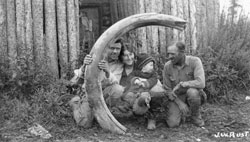|

The Artic National Refuge came about through
the hard work and long battle of Olaus Murie, Secretary Fredrick A. Seaton, and the people of the Alaskan territory. Olaus
Murie was a man who fell in love with the beauty and serenity of the northeastern area of Alaska
during the 1930’s while he worked for the U.S. Biological Survey, a predecessor to the U.S. Fish and Wildlife Service.
He spent a lot of time hiking, sketching, and recording the wildlife that encompassed the area. The beauty of the mountains,
springs, and rivers were what inspired him to become an advocate for the protection of the land. However, many people who
lived in the Alaskan territory that would soon become a state were confused as to what it meant to make an area a national
refuge. Many felt that it was the United States
government attempt at controlling portions of land from hunting and gaming. Therefore, it was greatly opposed. Murie and his
wife Mardy, understood Alaskans’ habitual antipathy toward government land withdrawals of any kind. Creating a giant
wilderness in northern Alaska required diplomacy. The couple
went out and gave demonstrations to church groups, community leaders, and anyone else who would listen on their proposal of
protecting the Alaskan wilderness. They often would give the presentation and not literally ask for support. They wanted people
to understand the meaning of national preserves and make the decision for themselves.
The
Muries needed someone’s support that had a foot in the door in government legislations. Therefore, they recruited the
help of the U.S. Interior Secretary Fredrick A. Seaton. The Muries and Seaton sat out to gain the support of the Alaskan people
and the United States government. On January
3, 1959 Alaska became a state in the United
States of America. The state’s first senator Ernest Gruening said that “Alaska seems to be happy the hunting ground of special interest, whether
it is for gold, salmon, or oil.” Gruening saw the development opportunity stemming from the oil industry as an economic
prospect for the Alaskan people. However, after many debates and opposition on December, 7 1960 Seaton issued Public Land
Order 2214, officially creating the Artic National Wildlife Refuge. On the contrary this land order opened twenty million
acres on the North Slope to civilian mineral leasing and mining. This detail opens the discussion
of the current debate of oil drilling in the North Slope region and the ecological effects
on the Artic National Wildlife Refuge. Although oil development was under way on the Kenai Peninsula of Alaska in 1960, and
the oil industry and federal government had drilled in many parts of Alaska before statehood, few Alaskans had inkling the
new state would become a major oil province.
In
August 2001, the U.S. House of Representatives passed a bill intended in part to open the door to oil drilling in Alaska’s Artic National refuge. In a provision of the bill it
is said that there would be limitations that limit the oil industry to only developing a mere two-thousand acres of the refuge.
The two-thousand acres would only address surface acreage covered by production and support facilities. Therefore, it would
only include where oil facilities actually touch the ground, nor would it cover land that would be excavated by pipelines.
However, the oil sights including drill sites, airports and roads for transportation, and the gravel mines would put a footprint
the size of twelve-thousand acres.
|

